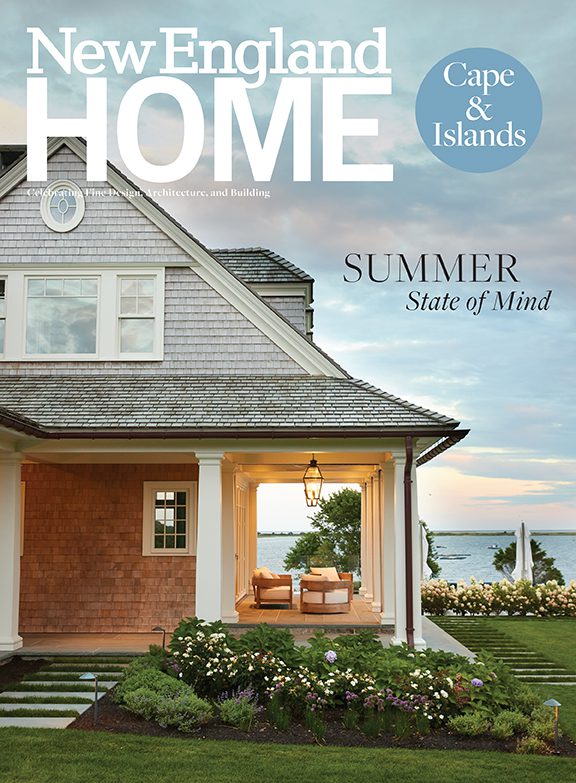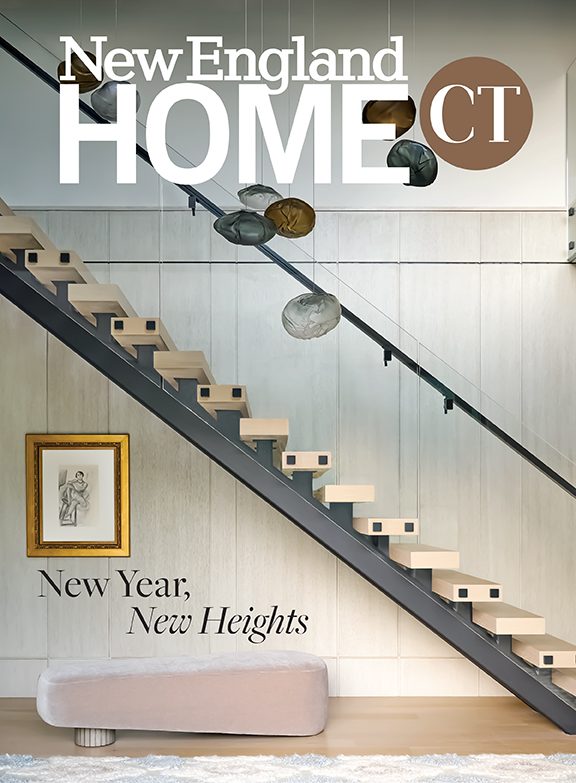Building Blocks of Great Design
May 27, 2010
Text by Regina Cole Photography by Courtesy of the Cape Ann Museum
The Wenham Museum’s antiques show took an unexpected turn in 2009, when the annual fundraiser became a juried design event with a singular theme. Calling the show “Tablescapes,” the museum gave designers an eight-by-eight-foot space and the following charge: create a tabletop vignette that reflects the culture and history of the North Shore of Massachusetts.
Eighteen participants more than rose to the challenge with displays that included a carpenter’s workbench alluding to the skills and traditions of the area, an Orient Express dining car relating to the museum’s train collection, a literary luncheon table that honored Ipswich resident John Updike, and ceramics inspired by views of Gloucester Harbor.
One of the most arresting vignettes featured an antique desk and hand-printed, mustard-colored textiles of extraordinary subtlety, wit and charm. With her Writer’s Desk exhibit, Elizabeth Brosnan Hourihan of the North Shore design-build firm Carpenter and MacNeille paid tribute to the artistry of the Folly Cove Designers. For Hourihan, the work of that now-defunct group has a certain kinship with the work of her company. “Their spirit was representative of our work,” she says.
Many of Carpenter and MacNeille’s clients have older homes that they want renovated with authenticity, requiring both a historic sensibility and an emphasis on fine craftsmanship. “Each detail has to relate to the whole, and love of the work must be evident,” she says. “The Folly Cove Designers personified that approach.”
From 1939 until 1969, the Folly Cove Designers produced original block-printed fabrics and wallpapers in Lanesville, a Gloucester village at the northernmost tip of Cape Ann. Patterned after a Medieval guild and informed by the neighborhood’s environment and culture, the artists’ collective was inspired by the belief that home goods should be beautiful as well as useful. Small and decidedly local, the group’s influence was huge: reference works consistently credit them with setting a new direction in American design.
In 1945, Life magazine identified the Folly Cove Designers as “a group of young married women who five years ago began making hand-blocked prints in their spare time.”
A charming image; not, however, entirely accurate. For one thing, there were male members throughout the design guild’s thirty-year history, though they were always in the minority. When ex-Marine Eino Natti joined immediately after World War II, his antique Acorn press replaced jumping on the block as the group’s printing method of choice.
Some of the forty-odd members were, in fact, wives of lawyers and architects, but the Folly Cove Designers were anything but dilettantes playing at art. The Life story points out that their fabrics sold “in at least fourteen leading department stores throughout the country,” including Lord and Taylor. F. Schumacher and Company obtained the rights to silk-screen several designs on fabric and wallpaper. The Folly Cove Designers exhibited examples of their work in national museums and at craft shows, including 1953’s Designer Craftsman USA, a seminal exhibition organized by the American Craftsmen’s Educational Council.
Forty years after the group disbanded, their placemats, table runners, aprons, potholders and yard goods fetch handsome sums on eBay. As a 2008 Vogue article pointed out, “Folly Cove prints have a timeless and universal appeal. At the same time, these colorful, handcrafted designs, bursting with natural motifs, could have been taken off the spring runways.”
The driving force behind all this extraordinary creativity was one dynamic woman.
Virginia Lee Burton, known to her friends and family as Jinnee, was forced to decline an invitation to dance with a New York ballet troupe when her father, an MIT dean, broke his leg and needed his daughter to stay home to tend to him. The beautiful nineteen-year-old became a sketcher at the Boston Transcript and took drawing classes at the Museum School. There, she fell in love with her teacher, the Macedonian-born sculptor George Demetrios. They married in 1930 and two years later moved to Gloucester.
When the effects of the Great Depression reduced the family income, Jinnee wrote children’s books, including Mike Mulligan and His Steam Shovel, The Little House, Choo Choo and Life Story. Considered classics, they have never gone out of print. If she had done nothing else, these books, illustrated by the author, would have secured Virginia Lee Burton’s place in history.
In 1938 a neighbor, Aino Clarke, proposed a swap: she, a gifted musician, would give violin lessons to the two Demetrios boys in exchange for design lessons from Jinnee. Aino admired the curtains Jinnee had created for her studio by cutting a design out of a linoleum block, applying ink and jumping up and down on the block placed on plain fabric.
Thus began informal study which, in short order, evolved into an organized, professional, juried guild of neighbor-designer-craftspeople whose work was sought after and who made money. The group stipulated that each designer would give 5 percent of their sales to the Folly Cove Designers, as well as 1.5 percent of the wholesale price of each piece. In 1941, annual dues were $2.
Burton, who refused the title of president, was nonetheless the guiding spirit; the group disbanded after she died. The then-youngest member purchased one of the two Acorn presses the group owned and set up shop in neighboring Rockport under the name Sarah Elizabeth. She passed away last year and her protégée, Isabel Natti, carries on the tradition. The Demetrios heirs donated the Folly Cove Designer material to the Cape Ann Museum with the stipulation that the blocks never again be printed.
“We all made a gentleman’s agreement,” says Lee Natti. “None of the original work can be reproduced.” Originally Virginia Lee Burton’s editor at Houghton Mifflin, Natti joined the Folly Cove Designers after her employer sent her to Folly Cove in the late 1940s to study the author’s graphic work. Natti met her husband-to-be and moved to Lanesville. She talks about the Folly Cove Designer years as one of the most stimulating periods of her long life.
The old carved blocks may never touch fabric again, but their bold, nature-based patterns continue to influence designers in varied and surprising ways. Many of the best-loved Marimekko patterns have a striking similarity, as do folkloric screen-printed textiles from F. Schumacher and Robert Kaufman. What is more, each time a young artist presses a carved and inked eraser or potato onto a sheet of paper or article of clothing, he continues the creative process pioneered by the group. The Folly Cove Designers showed the world how to create great home design with simple, inexpensive materials and processes.
“It’s time for a revival,” Hourihan says. Her design show entry led to an exhibition she describes as “a tribute to Virginia Lee Burton and the Folly Cove Designers” at the Annisquam Exchange last summer. “Three surviving Folly Cove Designers came, including Lee Natti, and they talked about a time in their lives that was so important,” she recalls.
“This summer, we hope to bring the show to Endicott College. What a wonderful thing to share with the young designers of today!” Hourihan adds. “The Folly Cove Designers believed in making things, in working with their hands and in working together. It doesn’t get any better.”
Share
![NEH-Logo_Black[1] NEH-Logo_Black[1]](https://b2915716.smushcdn.com/2915716/wp-content/uploads/2022/08/NEH-Logo_Black1-300x162.jpg?lossy=1&strip=1&webp=1)
















You must be logged in to post a comment.